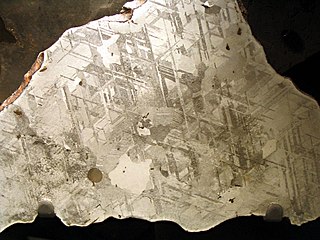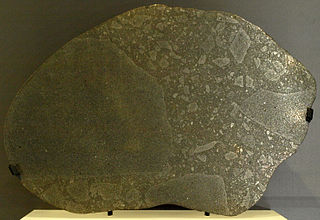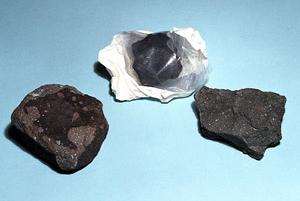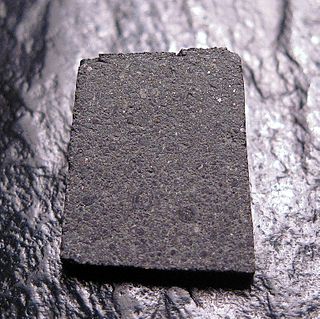Related Research Articles

Kamacite is an alloy of iron and nickel, which is found on Earth only in meteorites. The proportion iron:nickel is between 90:10 and 95:5; small quantities of other elements, such as cobalt or carbon may also be present. The mineral has a metallic luster, is gray and has no clear cleavage although its crystal structure is isometric-hexoctahedral. Its density is about 8 g/cm3 and its hardness is 4 on the Mohs scale. It is also sometimes called balkeneisen.

A meteorite is a solid piece of debris from an object, such as a comet, asteroid, or meteoroid, that originated in outer space and survived its passage through the atmosphere to reach the surface of a planet or moon. When the original object enters the atmosphere, various factors such as friction, pressure, and chemical interactions with the atmospheric gases cause it to heat up and radiate energy. It then becomes a meteor and forms a fireball, also known as a shooting star or falling star; astronomers call the brightest examples "bolides". Once it settles on the larger body's surface, the meteor becomes a meteorite. Meteorites vary greatly in size. For geologists, a bolide is a meteorite large enough to create an impact crater.

The Wold Cottage meteorite fell near Wold Cottage farm in 1795, a few miles away from the village of Wold Newton in Yorkshire, England.
The ultimate goal of meteorite classification is to group all meteorite specimens that share a common origin on a single, identifiable parent body. This could be a planet, asteroid, Moon, or other current Solar System object, or one that existed some time in the past. However, with a few exceptions, this goal is beyond the reach of current science, mostly because there is inadequate information about the nature of most Solar System bodies to achieve such a classification. Instead, modern meteorite classification relies on placing specimens into "groups" in which all members share certain key physical, chemical, isotopic, and mineralogical properties consistent with a common origin on a single parent body, even if that body is unidentified. Several meteorite groups classified this way may come from a single, heterogeneous parent body or a single group may contain members that came from a variety of very similar but distinct parent bodies. As such information comes to light, the classification system will most likely evolve.

A Chondrule is a round grain found in a chondrite. Chondrules form as molten or partially molten droplets in space before being accreted to their parent asteroids. Because chondrites represent one of the oldest solid materials within the Solar System and are believed to be the building blocks of the planetary system, it follows that an understanding of the formation of chondrules is important to understand the initial development of the planetary system.

Chondrites are stony (non-metallic) meteorites that have not been modified due to melting or differentiation of the parent body. They are formed when various types of dust and small grains that were present in the early solar system accreted to form primitive asteroids. They are the most common type of meteorite that falls to Earth with estimates for the proportion of the total fall that they represent varying between 85.7% and 86.2%.

Carbonaceous chondrites or C chondrites are a class of chondritic meteorites comprising at least 8 known groups and many ungrouped meteorites. They include some of the most primitive known meteorites. The C chondrites represent only a small proportion (4.6%) of meteorite falls.

The H type ordinary chondrites are the most common type of meteorite, accounting for approximately 40% of all those catalogued, 46% of the ordinary chondrites, and 44% of the chondrites. The ordinary chondrites are thought to have originated from three parent asteroids, whose fragments make up the H chondrite, L chondrite and LL chondrite groups respectively.

The ordinary chondrites are a class of stony chondritic meteorites. They are by far the most numerous group and comprise about 87% of all finds. Hence, they have been dubbed "ordinary". The ordinary chondrites are thought to have originated from three parent asteroids, with the fragments making up the H chondrite, L chondrite and LL chondrite groups respectively.

The Tagish Lake meteorite fell at 16:43 UTC on 18 January 2000 in the Tagish Lake area in northwestern British Columbia, Canada.

The LL chondrites are a group of stony meteorites, the least abundant group of the ordinary chondrites, accounting for about 10–11% of observed ordinary-chondrite falls and 8–9% of all meteorite falls. The ordinary chondrites are thought to have originated from three parent asteroids, with the fragments making up the H chondrite, L chondrite and LL chondrite groups respectively. The composition of the Chelyabinsk meteor is that of a LL chondrite meteorite. The material makeup of Itokawa, the asteroid visited by the Hayabusa spacecraft which landed on it and brought particles back to Earth also proved to be type LL chondrite.
Meteorite fall statistics are frequently used by planetary scientists to approximate the true flux of meteorites on Earth. Meteorite falls are those meteorites that are collected soon after being witnessed to fall, whereas meteorite finds are discovered at a later time. Although there are 30 times as much finds than falls, their raw distribution of types does not accurately reflect what falls to Earth. The reasons for this include the following:

The Allende meteorite is the largest carbonaceous chondrite ever found on Earth. The fireball was witnessed at 01:05 on February 8, 1969, falling over the Mexican state of Chihuahua. After breaking up in the atmosphere, an extensive search for pieces was conducted and over 2 tonnes (tons) of meteorite were recovered. The availability of large quantities of samples of the scientifically-important chondrite class has enabled numerous investigations by many scientists; it is often described as "the best-studied meteorite in history." The Allende meteorite has abundant, large calcium-aluminium-rich inclusions, which are among the oldest objects formed in the Solar System.

Pultusk is an H5 ordinary chondrite meteorite which fell on 30 January 1868 in Poland. The event has been known as the stony meteorite shower with the largest number of pieces yet recorded in history. Made up of rocky debris, it consists of pyroxene or olivine chondrules deployed in mass plagioclase, there being also kamacite.

Albareto is a meteorite which in July 1766 fell near the frazione Albareto, of Modena, Emilia-Romagna, Italy.

Enstatite chondrites are a rare form of meteorite thought to comprise only about 2% of the chondrites that fall on Earth. Only about 200 E-Type chondrites are currently known.

CI chondrites, sometimes C1 chondrites, are a group of rare stony meteorites belonging to the carbonaceous chondrites. Samples have been discovered in France, Canada, India, and Tanzania. Compared to all the meteorites found so far, their chemical composition most closely resembles the elemental distribution in the sun's photosphere.

Moss is a carbonaceous chondrite meteorite that fell over the communities of Rygge and Moss in Østfold county, southeast southern Norway in the morning of midsummer day, July 14, 2006.
The Itqiy meteorite is an enstatite-rich stony-iron meteorite. It is classified as an enstatite chondrite of the EH group that was nearly melted and is therefore very unusual for that group. Other classifications have been proposed and are an ongoing scientific debate.
This is a glossary of terms used in meteoritics, the science of meteorites.
References
- Hunterian Collection
- Bevan, A.W.R., Hutchison, R., Easton, A.J., Durant, G.P. and Farrow, C.M. 1985. High Possil and Strathmore - a study of two L6 chondrites. Meteoritics Vol. 20, pp 491–50